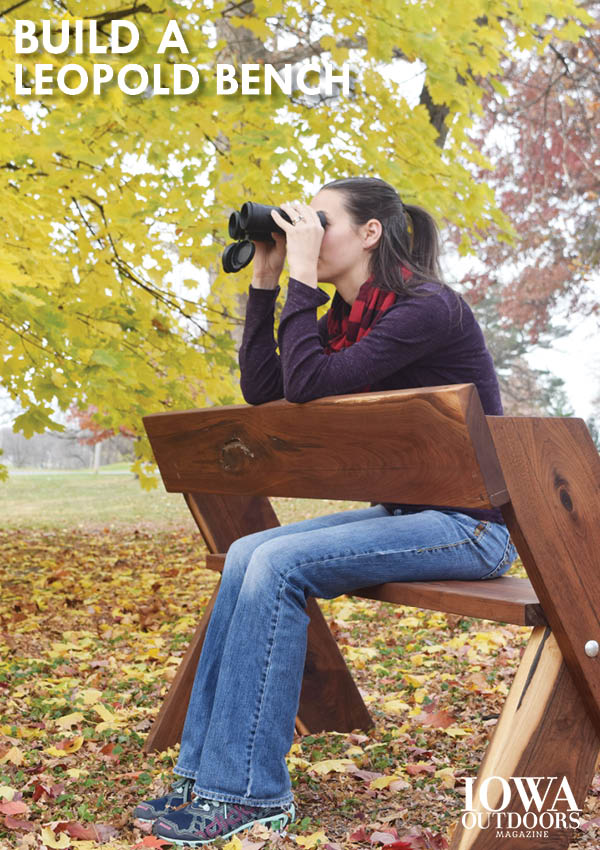From the March/April 2017 Iowa Outdoors
Subscribe now
 “At 3:30 a.m., with such dignity as I can muster of a July morning, I step from my cabin door, bearing in either hand my emblems of sovereignty, a coffee pot and notebook. I seat myself on a bench, facing the white wake of the morning star. I set the pot beside me. I extract a cup from my shirt front, hoping none will notice its informal mode of transport. I get out my watch, pour coffee, and lay notebook on knee,” writes Aldo Leopold in the classic book, A Sand County Almanac.
“At 3:30 a.m., with such dignity as I can muster of a July morning, I step from my cabin door, bearing in either hand my emblems of sovereignty, a coffee pot and notebook. I seat myself on a bench, facing the white wake of the morning star. I set the pot beside me. I extract a cup from my shirt front, hoping none will notice its informal mode of transport. I get out my watch, pour coffee, and lay notebook on knee,” writes Aldo Leopold in the classic book, A Sand County Almanac.
It was here, on his bench, that Leopold often observed the birds, forest and wildlife around him. At first glance, the bench design is indistinguishable from most other benches. But this model holds a functional usefulness not readily apparent. By sitting backwards with legs through the opening, the backrest now provides a sturdy support for the elbows while using binoculars or cameras to observe nature around you.
It is an easy bench to build, requiring modest skills, materials and about two hours of time. While Leopold never sketched the plans for his, free plans are aplenty online. The bench in the photos was built by DNR staff and displayed at the DNR building at the Iowa State Fair. Its walnut lumber came from the Yellow River State Forest in Allamakee County where it was milled onsite and was inscribed with a well-known Leopold quote—“Conservation is a state of harmony between men and land.”
Materials
• 2 x 6 x 48-inch board for backrest board
• 2 x 10 x 45-inch board for seat
• 2 x 8 x 10-foot boards for sides and legs
• (6) 3/8-inch x 3.5-inch carriage bolts with washers and nuts
• (12) 3/8-inch x 3.5-inch #12 or #14 flathead wood screws

About Aldo Leopold
 Aldo Leopold was born in Burlington in 1887. As a boy with a lively interest in studying birds and natural history, he spent hours observing nature and exploring the river bluffs. A top high school student, he studied forestry at Yale University, which offered the nation’s first graduate forestry program. Earning a master’s degree in 1909, he joined the U.S. Forest Service, still in its infancy, established in 1905 under ardent conservationist, President Theodore Roosevelt.
Aldo Leopold was born in Burlington in 1887. As a boy with a lively interest in studying birds and natural history, he spent hours observing nature and exploring the river bluffs. A top high school student, he studied forestry at Yale University, which offered the nation’s first graduate forestry program. Earning a master’s degree in 1909, he joined the U.S. Forest Service, still in its infancy, established in 1905 under ardent conservationist, President Theodore Roosevelt.
After just a few years, Leopold became supervisor of the 1.5 million-acre Carson National Forest in New Mexico (which was still a territory). Here, he developed the first comprehensive management plan for the Grand Canyon and wrote the Forest Service’s first game and fish handbook. He also proposed the first national wilderness area in the Forest Service system, the Gila Wilderness Area in New Mexico. He later taught at the University of Wisconsin and was at the forefront of wildlife conservation and management.
The internationally recognized scientist and gifted writer penned the non-technical classic, A Sand County Almanac in 1949, regarded as one of the century’s foremost books of the conservation and environmental movement. Using short stories, he examined humanity’s relationship to the natural world. Unfortunately, just one week after hearing it was to be published, Leopold died of a heart attack on April 21, 1948 while fighting a wildfire. With more than 2 million copies sold, it has become one of the most respected books about the environment ever published, and Leopold is regarded by many as the most influential conservation thinker of the 20th century.
Learn more at The Leopold Foundation at aldoleopold.org and his hometown group, leopoldheritage.org